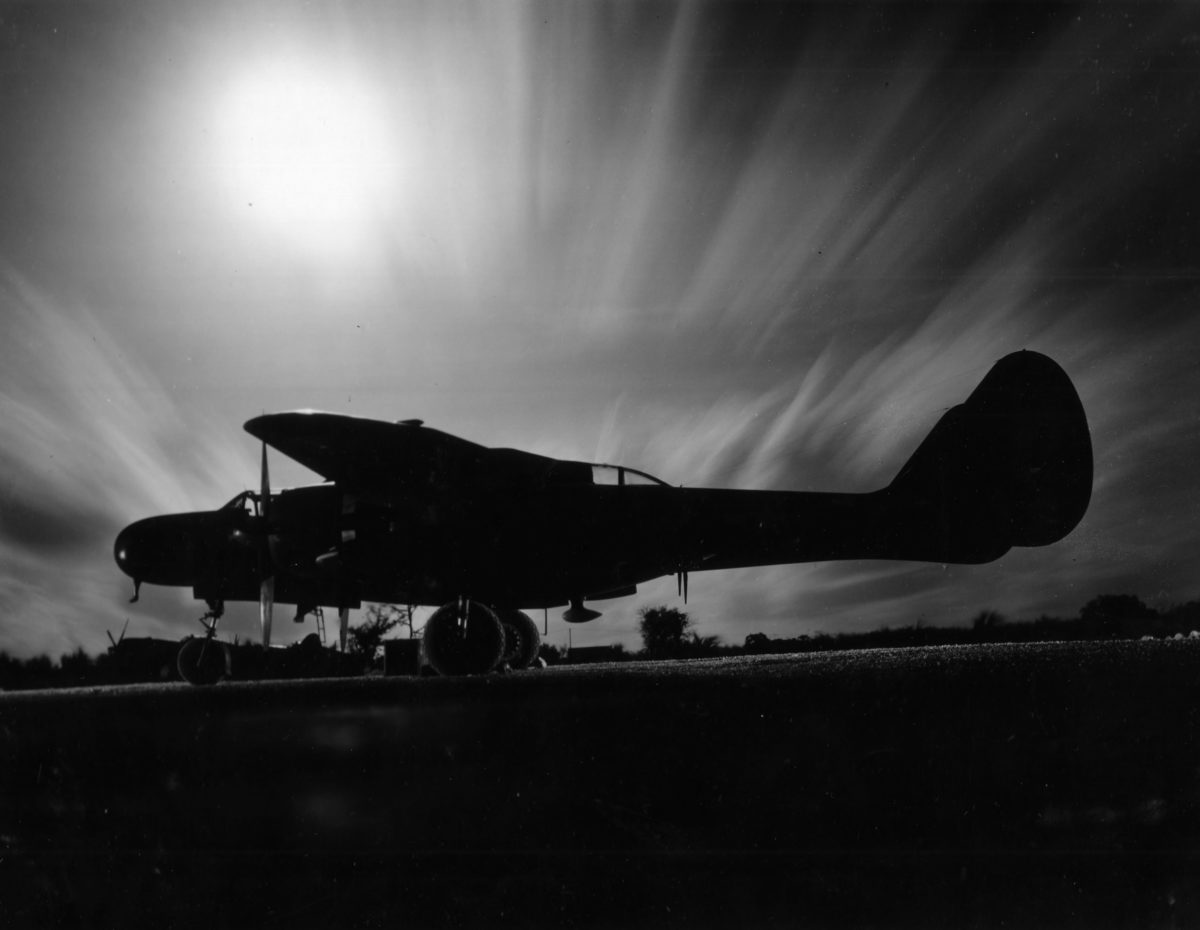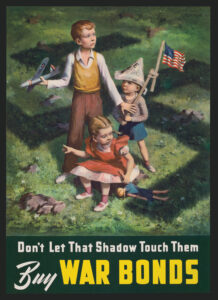In the middle of an uneventful patrol, the silence was suddenly broken when control radioed that it had detected an intruder coming straight toward Lieutenant Dale Haberman’s Northrop P-61A.
During World War I, military aircraft conducted operations primarily in daylight hours, aside from night bombing raids by the Germans and later the British and French. Early in World War II, the Luftwaffe and Royal Air Force were finding it so costly to bomb enemy targets during the day that by late 1940 they were flying the majority of their bombing missions at night. To counter this, defenders on both sides perfected airborne intercept radar that made night fighting more practical and removed the safety blanket that darkness had provided. Both Germany and Britain pioneered the development of radar and night fighting tactics.
When the United States entered the war in December 1941, the wheels were already in motion for production of a specialized American all-weather night fighter. Northrop won the contract for what would become the P-61 Black Widow, the first aircraft designed from the ground up for the task. It would carve out a widely feared reputation with both Japanese and Luftwaffe aircrews that flew night missions. The Widow’s lethal bite could rival anything the enemy had to offer. It bristled with four forward-firing 20mm cannons in the belly and a dorsal turret that held four .50-caliber machine guns (some of the early models were produced with no dorsal turret because mass production of the Boeing B-29 Superfortress was using up most of the turret production).
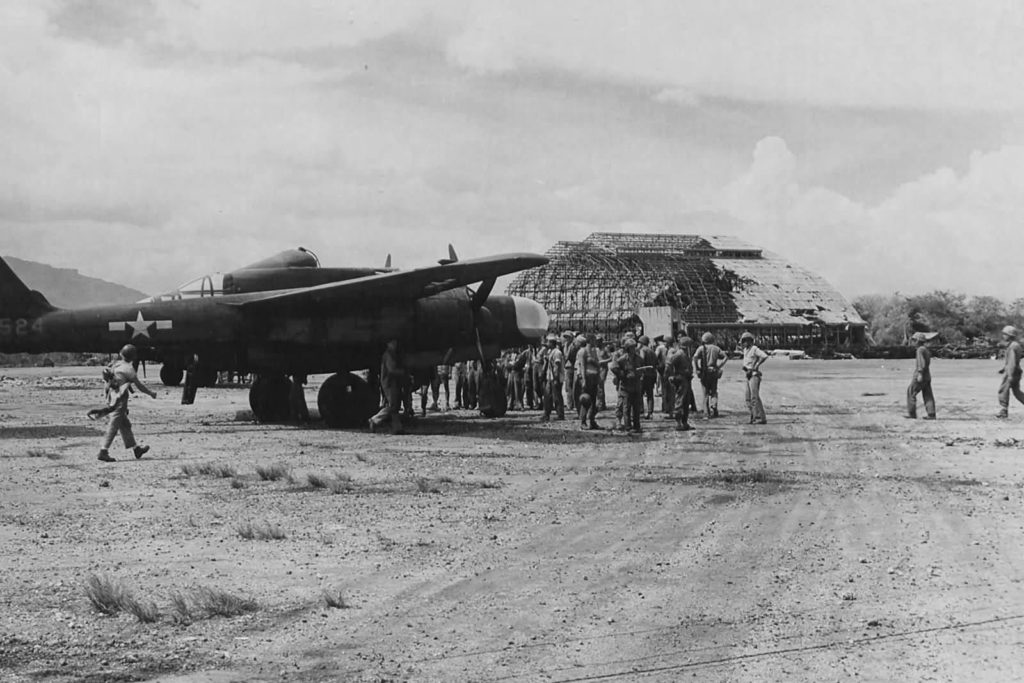
Even back in the early 1940s, a sophisticated aircraft like the P-61 could not be designed, tested and made operational in a few months. The first P-61s did not reach the forward areas in the Pacific until late June 1944. As a result, the Black Widow’s amazing record was compiled in just over a year.
The 6th Night Fighter Squadron was the first to receive the new aircraft. The squadron had already seen combat in the Pacific, flying the Douglas P-70, a night fighter developed from the A-20 Havoc. In early March 1944, the 6th was pulled back to Hawaii to prepare for delivery of the new night fighter, which began arriving in early May. A short time later, the squadron was checked out, and its pilots began their long flight to Saipan. They island-hopped from John Rogers Field in Hawaii to Palmyra Island, to Canton Island and on to Tarawa. From there they hit Kwajalein, Eniwetok and finally Saipan. Because Saipan was constantly raided at night by Japanese bombers, there was very little time for the 6th to get adjusted. Its crews were almost immediately thrown into demanding night patrols.
Two P-61 aircrews in the Pacific ended their tour with four confirmed kills, and one crew made ace. One of the four-victory crews, Lieutenant Dale Haberman and his radio operator (R/O) Lieutenant Ray Mooney, flew an early model P-61A named Moonhappy with the 6th NFS. On the night of June 30, 1944, just days after the 6th had gone operational on Saipan, they encountered a Mitsubishi G4M2 “Betty” bomber escorted by a Japanese fighter, most likely a Mitsubishi A6M5 Zero. What made this confrontation especially dramatic was the fact that the intercom exchanges between Haberman and Mooney were transmitted back to base during the harrowing duel, and the unfolding action drew a crowd of listeners.
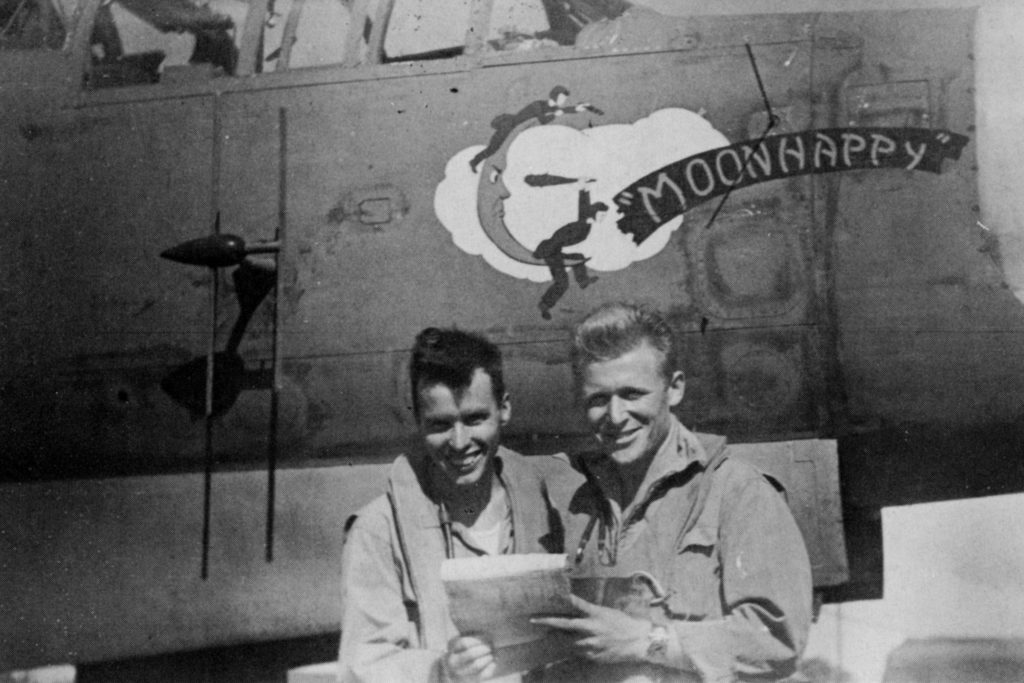
In the middle of an uneventful patrol, the silence was suddenly broken when control radioed that it had detected an intruder coming straight toward Lieutenant Haberman’s P-61. Of course the enemy pilot had no idea of the trap awaiting him as the Black Widow began setting up for the kill. Staying below the approaching Betty’s flight path until it passed over them, Haberman went to full power and did a gut-wrenching 180 in order to get in behind the enemy bomber, which was headed straight for Saipan and its airfields.
As they closed on the radar image, Lieutenant Mooney told Haberman to throttle back slightly because the single target had suddenly become two—one of which was a Japanese fighter tucked in close to the bomber. The enemy planes climbed to 17,000 feet, still unaware of the night fighter closing from their 6 o’clock position. As the gap narrowed to about 700 feet, Mooney told Haberman to start firing, and before he could finish his sentence the four 20mms opened up with a deafening roar as the P-61 continued to close. The cannon rounds walked all over the hapless Betty’s fuselage, and it immediately burst into flames, dropped its nose sharply and plummeted straight down to the water.
Haberman and Mooney had scored the first P-61 victory in the Pacific theater. The fight was far from over, however, as the lone Japanese fighter had moved far out to the side and eased in behind Moonhappy. Although the night fighters did not use tracer rounds for good reason, the enemy fighter pilot had probably been in a position to see the fire coming from the 20mm barrels as Haberman flamed the Betty. From there, he moved in on the P-61’s rear.
It didn’t take long for Mooney to realize where the second enemy plane had gone. He yelled: “Look out Hap! There’s a Jap fighter on our tail!” Listeners back at squadron ops were held spellbound by the silence that followed. In the interval the enemy fighter fired a burst that missed wide. Once he had been alerted to the danger, Haberman dropped his port wing with the nose of the P-61 pointed down at a steep angle, heading for the deck at full throttle. As he plummeted he kicked the rudders, taking evasive action to make sure the bogey was not still on his tail.
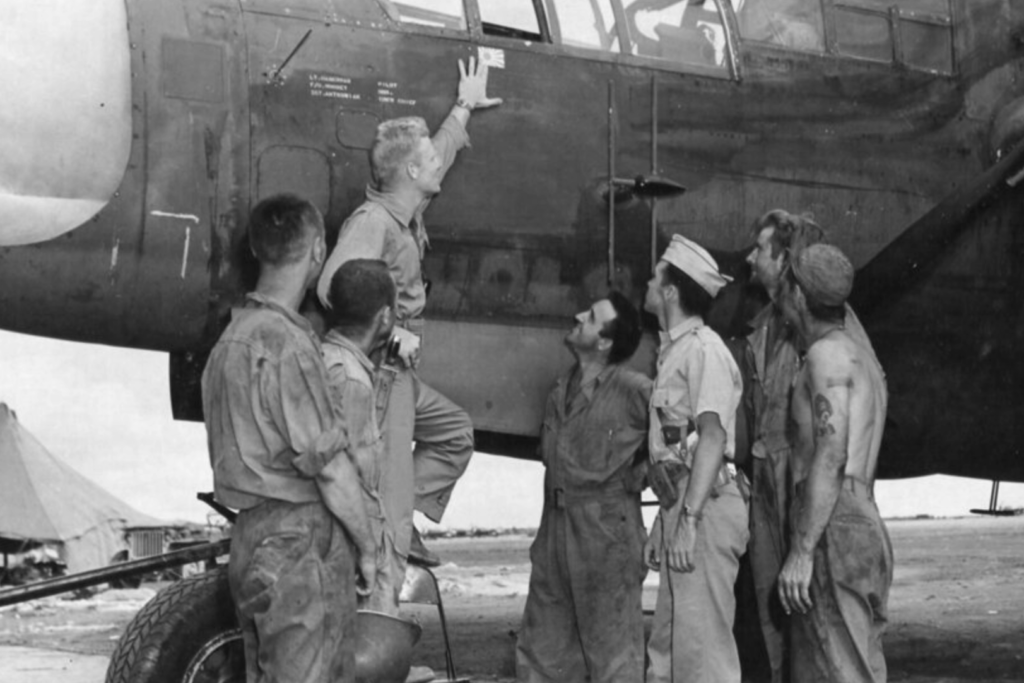
At about 1,200 feet above the water, Haberman leveled off, still maintaining maximum airspeed. Then he made a quick turn, hoping to go back and get a radar lock on the enemy plane, but nothing showed up. The fighter had disappeared into the night. It was an unusual incident: The Betty had probably been serving as the fighter’s eyes and ears, and that’s why he had been tucked in so close, making only one blip on the radar screen.
On Christmas night 1944, the Japanese intensified their nocturnal attacks against Saipan. The squadron intercepted many of the raiders and shot down several. Lieutenant Robert L. Ferguson, a pilot in the 6th, was flying in his assigned P-61A-5 named The Virgin Widow. He vividly recalled that mission, during which his Black Widow made a spectacular kill: “We scrambled at 2200 hours and it didn’t take long to get airborne because our equipment—oxygen masks, helmets and parachutes—was already in the cockpit, and when we were dropped off on the flight line, the crew chief was ready to strap us in and by 2204 hours we were airborne. Control directed us close enough to get a radar contact at seven miles. We were drawn lower and lower and finally, at 1,500 feet, I figured we were tracking a surface craft and didn’t want to fly into the water. This type of intercept happened many times and we had to check every one out because sometimes the Japanese bombers came in right above the water.”
With enemy activity unusually high, it didn’t take long for control to radio another contact to the P-61 crewmen. They were told to steer 180 degrees, with the bogey 45 miles out flying at 10,000 feet. Within minutes, the intruder’s altitude increased and control told them to move up to 15,000 feet. By this time the R/O had a contact at five miles, with the target slightly above them. The overtake speed was 40 mph. When the range decreased to 2,500 feet, Lieutenant Ferguson put down flaps and reduced speed by at least 50 mph in order to ease in from behind on the bogey’s blind spot. Without warning, however, the target began to accelerate.
“My closure was lost when he started pulling away,” Ferguson said, “so I pulled the flaps and this gave me a boost that settled us in behind at about 1,200 feet, where I was able to get a visual. I continued closing down to 300 feet, where I positively identified it as a Mitsubishi Betty bomber, which was very fast [280 mph] with a long range of over 2,500 miles. I moved in directly behind and level with him before firing a short burst into his port engine and the forward part of its fuselage. Seconds later, I observed a small explosion in the fuselage, which quickly turned into a red glow as the fire spread just behind the wing root and the Betty’s airspeed dropped abruptly, causing me to make a sharp turn to port while throttling back to avoid an overshoot. We eased up alongside the stricken bomber, gradually easing back to try and get behind him for another 20mm burst. I put a few rounds into it and the nose dropped and by now the entire aircraft was engulfed in flames. It went straight into the ocean and exploded on impact.”
Lieutenant Ferguson was given another vector that proved to be a surface craft, so he returned to Saipan and landed at 0240. The crew chief confirmed that they had expended a total of 100 20mm rounds with all four guns firing. The Virgin Widow was a virgin no more, and the next day Sergeant Miozzi, Ferguson’s crew chief and the squadron artist, painted a wedding ring on the widow’s left hand.
The top scorer that Christmas night was Moonhappy. Lieutenant Haberman took off on his patrol at 2000. During the next two hours and 20 minutes, he and his crew would be credited with a double kill—two Betty bombers. On direction from their controller (Coral Base), they set up a figure-eight orbit north of Saipan at an altitude of 15,000 feet. The patrol started out uneventfully, with no bogeys showing up on control’s radar. Then Coral Base called to say they were getting a lot of snow on their screen and some blips that indicated several intruders headed toward the island. Haberman was vectored toward the one closest to him, and at five miles Lieutenant Mooney picked it up on his scope. This one proved to be a little different, as it appeared to be orbiting.
Finally, after a few minutes, the bogey straightened out and headed north. Moonhappy gave chase and quickly narrowed the gap. The intruder proved to be far below them, so Haberman cut back on power and dropped down to 9,000 feet, putting Moonhappy in position to close from the rear at the same altitude. The gunner, Private Patrick Farrelly, got a visual from about 2,000 feet, and after a few seconds the Americans were close enough to see they had intercepted a Betty that wasn’t aware of their presence. Beginning at 1,500 feet, the Black Widow fired short bursts as it closed to 700 feet. Some of the rounds hit the target, causing the enemy pilot to make some drastic maneuvers in an effort to shake the night fighter. Haberman stayed focused and hung onto the Betty’s tail, continuing to pump shorts bursts into its wing root and fuselage.
Haberman recalled what happened at this stage of the pursuit: “As the enemy bomber made violent turns to try and get away from my guns, I stayed in close and continued to pepper him all over. At that point, the Betty’s pilot put it into a slight dive and evidently had it at full throttle because we were hitting speeds of 320 mph or better. Then he rolled to port in an imbalance of split-S and nosed straight down with flames coming out of his right wing and right engine. For a few moments, we lost visual on the target at about 6,000 feet as it went through some thin clouds completely out of control. It was counted as a kill because there is no way that the aircraft could have pulled out and it probably fell into the water in scattered pieces. But we didn’t have much of a chance to catch our breath.”
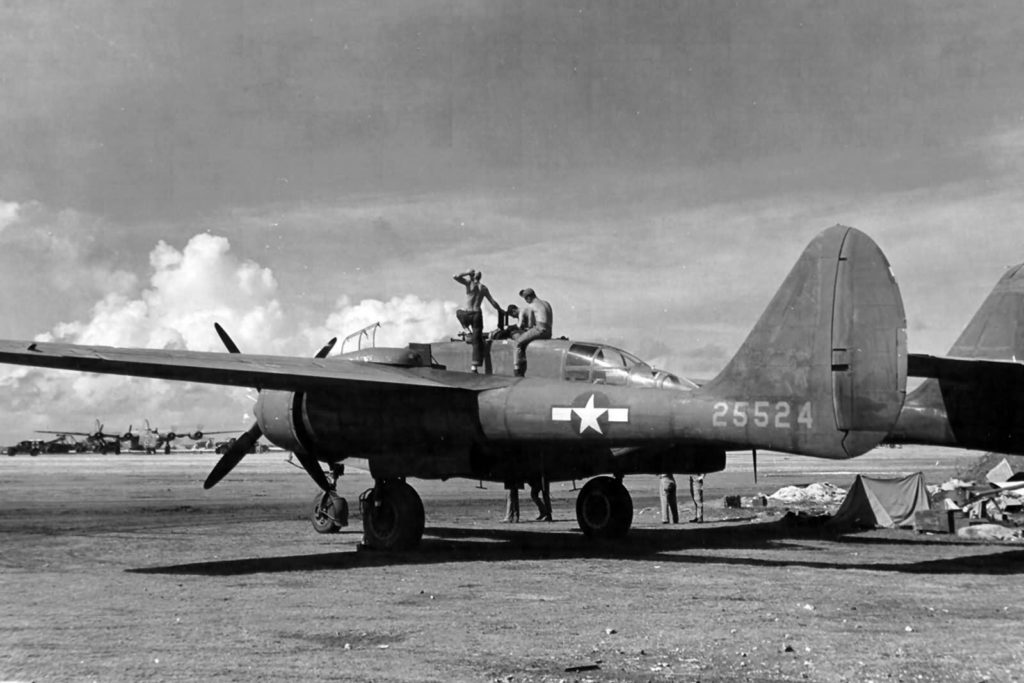
Just moments later, Lieutenant Mooney had another blip on his airborne interception (AI) scope. The second bogey was only two miles away, so its pilot had probably seen the fireball of Haberman’s first kill. It is a wonder that any of the Japanese bombers remained in the area if they were in radio contact with each other, since the 6th’s aircraft made several kills within a short period of time.
Moonhappy closed very fast with the second intruder, which was down low, at about 4,500 feet. The moon was well positioned, so the crewmen were able to make a visual identification 2,500 feet from the target. When they had closed to within 700 feet, Haberman opened up with everything he had. The rounds from all eight guns bracketed the bomber, and it exploded violently. There was no time to react before Moonhappy waded into the scattered debris. Fortunately for the crew, the only damage done to the P-61 was to the left cowling. This time the Americans were able to track the flaming wreckage all the way down to the water. At this point they were 160 miles from Saipan, but they had no trouble making it safely back to base. They had burned 550 gallons of fuel on the mission and fired 327 20mm rounds and 525 rounds of .50-caliber. It had been one of the 6th Squadron’s most rewarding patrols of the war.
The 548th Night Fighter Squadron did not receive its Black Widows until September 1944. The unit’s first foray into the forward areas was on Saipan, and from there it flew out of Iwo Jima and Ie Shima before war’s end. The 548th’s aircraft had some of the most elaborate nose art of any night fighter unit. Although the squadron’s combat tour didn’t last long, it was credited with five victories. One of its crews, pilot Captain James W. Bradford and R/O Lieutenant Lawrence Lunt, chalked up a kill in Midnite Madness on June 24, 1945.
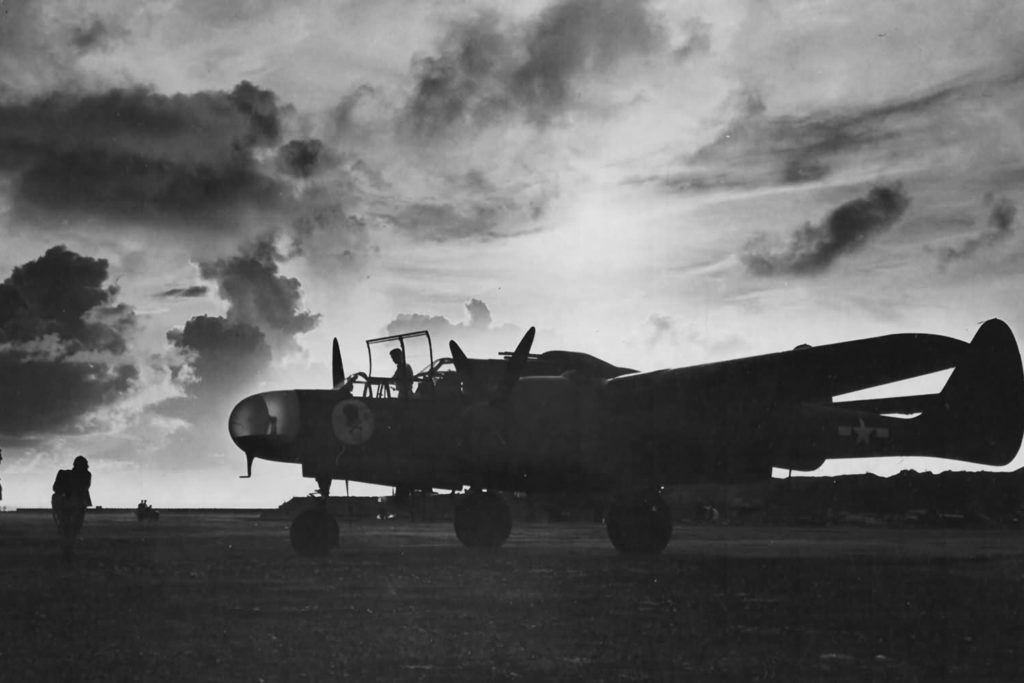
Captain Bradford recalled that mission: “We were airborne at 1835 hours, which put us up at dusk. It had been an uneventful patrol and it looked like there would be no action when we got a call from control at 2120 hours. They had just picked up a possible bogey coming into our area at 20,000 feet and 30 miles southwest of Point Charley. I immediately started a climb up to 23,000 feet as we headed in that direction. Lieutenant Lunt picked up the AI contact at a distance of eight miles and five degrees above, and he would control the intercept until we were close enough to get a positive visual identification. On this mission we had our gunner, Master Sgt. Reno Sukow, with us, which gave us another set of eyes. Our external tanks were almost dry, so we dropped them to give us more speed and maneuverability. Our ground control gave us a vector that would get to the intruder in the shortest period of time.
“The closure was fast and the bogey maintained a steady airspeed with no evasive action, so he was clueless as to what was coming up from the rear. Sergeant Sukow was perched up in the gunner’s compartment with night binoculars, and this allowed him to get a visual at 7,000 feet out. He talked me in as we closed, and at 2,000 feet I was able to see the enemy aircraft and it was a Betty bomber. From that point on, he was easy to track because we had a full moon and I was careful to close behind and below so we were in their blind spot. I eased into position to fire a short burst at about 700 feet and it didn’t seem to have any effect on the enemy bomber. A long second burst converged on his port engine and it immediately burst into flames, which quickly spread to the fuselage. In that glow, we saw the large rising sun painted on the side.”
Bradford fired a third burst that amplified the flames already starting to engulf the fuselage. The Betty then turned into a slight glide to port, still closely followed by the Black Widow. At first the enemy pilot seemed to have good control of his aircraft even though fire was consuming it, but then the nose dropped and he lost about 5,000 feet in altitude. Suddenly the Betty exploded in a huge fireball. Large pieces of the aircraft fell straight down into the ocean, where it continued to burn until the water extinguished it. Midnite Madness lingered briefly at 1,500 feet until Lieutenant Lunt picked up some returns on his scope, which turned out to be “window” (chaff) that had been dispersed by the doomed bomber. In the final report on this kill, it was noted that the mission had consumed 660 gallons of gasoline and 600 rounds of 20mm.

this article first appeared in AVIATION HISTORY magazine
Facebook @AviationHistory | Twitter @AviationHistMag
Lady in the Dark, another P-61 from the 548th NFS, was one of the most photographed Black Widows in the Pacific theater. Captain Lee Kendall was Lady in the Dark’s assigned pilot. What this Black Widow did at war’s end bordered on unbelievable: It scored the final two kills of WWII—one on the last night and one almost 24 hours after hostilities had officially ended—without firing a shot!
On the night of August 14, 1945, Lady was flown by another crew and in a low-altitude pursuit when the enemy fighter hit the water and exploded without a single round being fired. The war ended at 2400 that night, but there remained the possibility of night kamikaze attacks against American airfields. Therefore, the P-61s remained on alert.
The following evening, Captain Kendall took off at 1910 for a routine patrol. Less than an hour later the controller said he had a possible bogey coming toward the P-61 at an altitude of 4,500 feet. Contact was made quickly, and Kendall’s radar observer picked up window several times, which meant the intruder was using defensive tactics as he got closer to Ie Shima. As the Black Widow closed, the intruder made some hard turns in an effort to shake any pursuit.
Kendall recalled the chase: “Getting close enough for a positive identification proved to be difficult. He was taking violent evasive action and dropping window, which was bundles of tinsel-like strips of aluminum foil designed to confuse our radar. This guy knew we were behind him but I have no idea how he knew. My R/O, Lieutenant Scheerer, was talking me in closer to about 800 feet when all of a sudden the left side pilot’s window popped open and the rush of air drowned out the communications with him. Down this low at such a high speed and not being able to understand my observer was very unhealthy.
“I had to back off, secure the window and then get back in touch with him. In the meantime, I lost contact with the bogey, but quickly picked him up again and was able to close on his tail again despite his defensive moves. I had one eye on my target and one eye on my altimeter. Suddenly, the window popped open again and once again I closed it, and as I picked him up for a third time the same thing happened again! Regardless, I went after him for a fourth time and control gave me permission to shoot him down even though we didn’t have a positive identification.”
Kendall locked on again, and a few seconds later the bogey completely disappeared off the scope and no more window was detected. According to witnesses on the ground, the intruder crashed and the debris was scattered over a wide area. It had been a Nakajima Ki.44 “Tojo” fighter that probably was up to no good. Lady in the Dark had prevented him from carrying out his mission, assuming he had one. This was not listed as an official kill because the war had already ended. But the fact remains that a Black Widow had made the final two kills of World War II without firing its guns.
Warren Thompson has been collecting material for 40 years on all aspects of military aviation from 1937 to the present. He spent more than 10 years researching and contacting WWII night fighter pilots, resulting in numerous articles and two books, P-61 Black Widow Units in World War II and P-61 Black Widow, which he recommends for further reading.
Originally featured in the November 2008 issue of Aviation History. Subscribe here!

